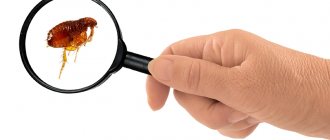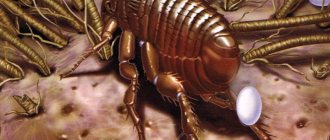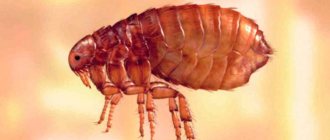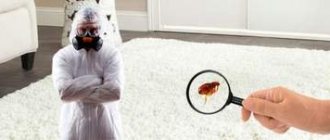Fleas have been “accompanying” human life since the very time when he had his first pet. Typically, these blood-sucking insects parasitize our pets - cats and dogs, and therefore we inevitably encounter them.
Although they adapt to specific animals, when there is a shortage of food, human blood is quite suitable for parasites. Therefore, our article is about what the insect is and how it spreads, what harm it causes to humans, and whether it is possible to get rid of fleas once and for all.
Can dog or cat fleas live on people?
Fleas don't live on humans, but they can still bite us. The most common are cat fleas. They can feed on both cats and dogs, so don't let the name fool you. There are also dog fleas, but they are less common.
Fleas can also feed on other mammals and birds, such as rodents and livestock. There are 2,500 different species of fleas in the world.
Some animals are attracted to fleas because of their fur or feathers. They may burrow into their furry bodies to hide and feed. They then lay eggs, which eventually hatch after the larval and pupal stages. This cycle can cause your pet to become infected with fleas and will need to be treated.
Fleas don't live on humans because we don't have strong fur like animals do, and they have a very difficult time reproducing without the protection of fur or feathers. One laboratory study found that a flea must feed on a human for 12 hours straight to be able to lay viable eggs. It is very rare that a flea can feed on a person for so long without being found and removed.
Insect development cycle
The flea development cycle can take from 10 days to several months. It all depends on environmental conditions. In warm weather, reproduction occurs as quickly as possible; with the onset of cold weather, it slows down or temporarily stops.
Insects develop in 4 stages:
- The adult lays eggs. Most often, they roll off the host animal and spread freely throughout the apartment.
- A worm-like larva about 1 mm long emerges from the egg, capable of moving independently. It usually lives in the cat's bedding and feeds on the feces of adult fleas, dried blood and various organic debris.
- The larva develops, molts three times and pupates, entangling itself in a silk-like cocoon.
- After some time, an adult insect is born.
Eggs are very resistant to adverse factors. They can lie in some secluded corner for months, maintaining their viability. As soon as suitable conditions arise, their development cycle resumes. The most favorable temperatures are considered to be +18…24 °C and air humidity of about 60%.
For your information. The average lifespan of an adult flea is 2-3 months. During this time, she manages to lay 500-800 eggs.
Do fleas bite people or not?
Fleas can bite people, most often on the feet, ankles and legs. They can bite three times in a row. This is called "breakfast, lunch and dinner."
Usually the first bites do not cause damage to the skin, but if a person is exposed to fleas for a long period of time, a hypersensitivity reaction may develop.
What does a flea bite look like on the human body?
The visual effects of flea bites can last for several days, but may get worse if you are more sensitive to the bites or if the area of the bite becomes infected.
Exception to the rule
There is a separate type of ectoparasite that can live in the human body for a short time. This is a sand flea that inhabits tropical beaches. Distributed in Brazil, Nigeria, India. You should be careful when visiting tropical countries.
The sand flea strongly bites the skin and, thanks to its one-millimeter body length, easily penetrates into the deep layers, reaching blood vessels. It lives inside the human body for up to 7 days until the eggs finish maturing.
The sand flea is dangerous because it causes a serious inflammatory disease - sarcopsillosis.
Do fleas pose any other dangers to people, pets or homes?
Fleas are more than a nuisance. In fact, they can cause several serious illnesses and can be fatal to animals if the infestation is so severe that it affects overall health.
Flea diseases
Fleas can carry several different diseases that can be transmitted through a bite. The most common are plague and typhus.
Both of these diseases are caused by bacteria and require treatment, such as antibiotics.
Allergic reactions
A flea bite can cause an allergic skin reaction because your body reacts strongly to the flea's saliva.
An allergic reaction to a bite can cause flea dermatitis. It may cause the following symptoms:
- irritated, red skin
- severe itching
- hives
- infection
Allergic reactions to flea bites can also occur in animals. An allergic reaction may cause the animal to scratch the bites to the point where skin appears or hair falls out.
Risk of tapeworm infection
Fleas can carry tapeworms. If you or an animal ingest a flea, you may become infected with a tapeworm. Children may be more likely to accidentally ingest a flea.
Tapeworms may not cause any harm to your overall health or the health of your pet, but if you notice something white and similar to a pumpkin seed in your or your pet's feces, it could be a sign of tapeworms. If you suspect this, contact your doctor or veterinarian.
Treatment of bites
The bite area is immediately washed with soapy water and disinfected with alcohol. Ice helps relieve swelling.
At home, honey and lemon lotions and used tea bags are used. Apply compresses with a decoction of mint, plantain, bird cherry, and dandelion leaves.
Allergic reactions are eliminated with the help of antihistamines, antipyretics and sedatives. Special ointments are effective, for example Fenistil.
How to get rid of a flea infestation
You will need to treat both your pet and clean the house if you suspect a flea infestation. There are several ways to get rid of fleas.
How to remove fleas from your pet
- Talk to your veterinarian about the safest and most effective method for removing fleas.
- When caring for your pet, use a flea comb.
- Before bathing, leave the soap on your pet for at least 5-10 minutes.
- Use a veterinarian-prescribed flea medication that kills fleas.
- Follow directions for using over-the-counter flea products carefully.
- Protect your pet by not using flea removers on his eyes, nose, and mouth.
- Wear gloves and other protective equipment when applying flea removers.
How to Remove Fleas from Your Home or Yard
- Wash pet beds and other fabric toys or rugs in hot water.
- Vacuum thoroughly and place any debris collected by the vacuum cleaner in a plastic bag, sealing it and disposing of it immediately.
- Apply insecticides to baseboards, but make sure they are not harmful to pets.
- Clean all upholstery (furniture, rugs, carpet, window bedding) frequently.
- Seal holes where wild animals can enter or near your home.
- Remove trash from around your home.
- If you suspect you have a serious flea infestation, call a pest control service.
Control of parasites in animals
You can tell if a cat is infested with fleas by several signs:
- the animal often itches and bites itself;
- the cat's skin becomes covered with red spots - traces of bites;
- Black dots appear in the fur - flea excrement.
If there are a lot of insects, they can be easily seen with the naked eye if you part the fur. A kitten picked up on the street can become a real breeding ground for parasites.
If you don't take action, your cat's body will weaken. The animal will become lethargic, its appetite will worsen, and it will have problems sleeping. Due to constant scratching, the bite sites become inflamed, abscesses, fistulas, and allergic dermatitis form.
To prevent fleas from passing from cats to humans, they must be gotten rid of immediately. The most popular method is to bathe your pet with insecticidal shampoo. Modern detergents kill insects from the first use.
There are other ways to get rid of fleas in cats:
- Anti-flea collar – can be impregnated with repellent or insecticide. In the first case, the accessory only repels fleas, so it is better to put it on an already treated cat. Collars with insecticidal substances destroy insects, but in the area of the hind legs and tail their effect is practically not felt. The validity period depends on the composition of the product, usually it is 2-3 months.
- Sprays can both repel and kill fleas. The drug is applied to the entire body of the animal, so there is no chance for insects to sit on the tail or thighs. Disadvantages - the likelihood of intoxication in cats with hypersensitivity, the result lasts only 5-10 days.
- Drops are concentrated solutions with insecticides or repellents. They are applied to the back of the head, which is not accessible when licking. However, the animal runs the risk of poisoning if the owner exceeds the recommended dosage or applies the product to an easily accessible place.
- Tablets are a relatively new development. The active ingredients enter the cat's bloodstream and destroy fleas during a bite. Within a few days, all toxic substances are eliminated from the animal’s body. Cons: additional stress on the liver and kidneys. Such drugs are used only under the supervision of a veterinarian.
Manufacturers produce a whole series of products to combat fleas in cats. Among them you can find all the indicated types of drugs.
Brands that have proven themselves well:
- "Leopard";
- "Ms.Kiss";
- "Beaphar"
- "Doctor Zoo";
- "4 with a tail";
- "Bravecto";
- "Frontline";
- "BlochNet."
Before using any drug, you must carefully read the instructions. Some products cannot be used on kittens, pregnant and lactating cats, weakened and elderly animals.
Important. Fleas develop immunity to insecticides that are constantly used on cats. Therefore, it is not advisable to constantly use the same product.
How to prevent fleas from spreading in your home
You can avoid flea infestations in your home in several ways, such as:
- Check your pet regularly for fleas
- clean your pet's sleeping place
- Don't let your pet go into places where there may be fleas from other animals, such as barns
Let's sum it up
Fleas can bite people, but they live on animals and in their bedding areas. Flea bites can be irritating and cause more serious health problems that require treatment from a doctor. Make sure you monitor your pets regularly for fleas and keep your home clean to reduce the likelihood of a flea infestation.
Sources:
Impulse follows strict sourcing guidelines and relies on peer-reviewed studies, research institutions and medical associations. We avoid using insufficiently expert links.
- Cat flea. (n.d.). portal.ct.gov/CAES/Fact-Sheets/Entomology/Cat-Flea
- Fleas. (2008). extension.entm.purdue.edu/publichealth/insects/flea.html
- Fleas. (2018). betterhealth.vic.gov.au/health/ConditionsAndTreatments/fleas
- Garcia E, et al. (2004). Immune and histopathologic examination of flea bite-induced papular urticaria. DOI: 10.1016/S1081-1206(10)61781-4
- Houseman, R.M. (2014). Fleas. extension2.missouri.edu/g7380
- Youssefi, M.R., et al. (2014). Dermatitis caused by Ctenocephalides felis (cat flea) in human. ncbi.nlm.nih.gov/pmc/articles/PMC4247491
Preventive measures.
Preventing fleas is easier than fighting them. For prevention purposes, follow these simple recommendations:
- Cleanliness is the key to freedom from pests. Pay special attention to secluded places where it is difficult to clean.
- Fill all gaps in baseboards, window frames and doorways.
- Provide your animals with flea collars.
- Frequently and promptly wash the rugs on which your pets sleep and rest.
- Place bouquets of aromatic herbs in the corners to repel insects.
- Periodically wipe all surfaces in the house with a soda solution.
If you find at least one individual flea, do not put off fighting them until later, call a special pest control service.
Where do “uninvited guests” come from?
Most often, ectoparasites live in the basements of houses, from where they ascend into the home for a source of food. They can also settle in attics, where bird nesting areas provide excellent shelter. The human flea is capable of remaining without food for a long time, courageously enduring unfavorable conditions.
Their ways of entering a home are numerous and do not cause any particular difficulties:
- fall with shoes and clothes;
- climb through cracks or ventilation ducts from neighbors;
- transmitted from stray cats or dogs;
- crawl off mice and rats if they appear in apartments;
- jumping through open windows or doors;
- spread from person to person.
It is important to notice the “enemy” in time and get rid of it as soon as possible, otherwise the flea will cause a lot of trouble and trouble to the inhabitants of the home.
Features of parasitism
The life cycle of fleas does not depend on a specific animal. They need blood to reproduce. They receive the necessary portion and return to their usual habitat. In city apartments this could be:
- pet beds and houses:
- mattresses;
- sofas and armchairs;
- textile toys;
- spaces behind furniture;
- cracks in the floor and poorly pasted wallpaper.
The flea remains viable even if it does not receive blood for a long time. In this case, suspended animation (hibernation) does not occur. The parasite loses the ability to reproduce, but continues to move in search of food. Fleas recognize their prey thanks to their excellent sense of smell and sensitivity to temperature fluctuations and vibrations.











